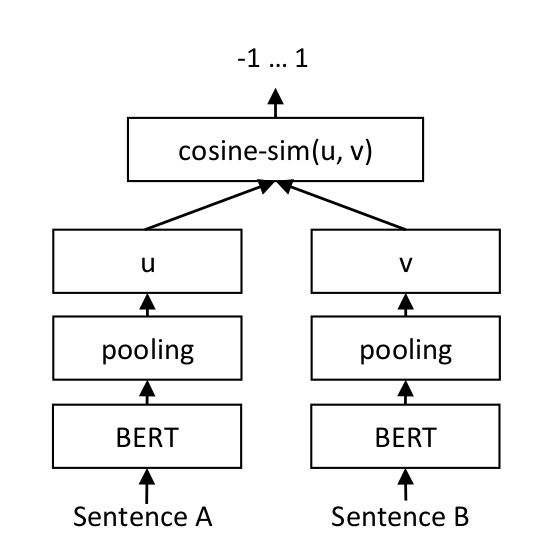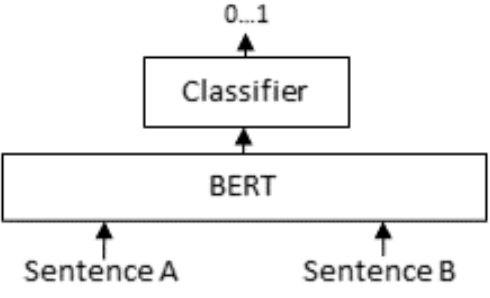In exercise 1, I trained 2 different models for SemEval Task 1. For paraphrase identification task, I utilized a binary classifier model to detect if given sentence pairs are paraphrase or not. For sentence similarity, I trained a regressor to minimize the sentence embeddings given 2 sentence pairs. For both approach, I utilized pre-trained language transformers to increase the speed of learning. This approach helped me to achieve good results in short training time.
Paraphrase detection model uses pre-trained distilled version of the RoBERTa-base model. The model uses distilroberta-base as a cross-encoder and adds a classification head on top to predict the probability of a sentece pair are paraphrase of each other.
To train the binary classification model for paraphrase detection, run python train_similarity.py.
Similarity model utilizes bi-encoder transformer from pretrained all-mpnet-base-v2 of Sentence Transformers. After encoding both sentences, it minimizes the cosine similarity between sentences given a similarity label.

To train the model, run python train_similarity.py.
To generate the predictions for the test set, run python predict_scores.py. There are two options to get the scores. If you use --only-similarity-model flag, it will only use similarity model for predictions. Basically, cosine similarities are considered as the is_paraphrase probabilities.
- The prediction file using only similarity model can be found in
systemoutputs/PIT2015_transformer_only_similarity_scores.output - The prediction file using both models can be found in
systemoutputs/PIT2015_hybrid_scores.output
| size_of_test_data | name_of_the_run | F1 | Precision | Recall | Pearson | maxF1 | mPrecision | mRecall |
|---|---|---|---|---|---|---|---|---|
| 838 | hybrid | 0.715 | 0.636 | 0.817 | 0.720 | 0.824 | 0.877 | 0.777 |
| 838 | only_similarity_model_scores | 0.784 | 0.916 | 0.686 | 0.720 | 0.824 | 0.877 | 0.777 |
As it can be seen from the table, there is a trade-off between precision and recall for paraphrase identification. Hybrid model has better recall and only_similarity model has better precision. However, F1 score encourages only_similarity_model approach.
Detoxify is a pre-trained language model that has been specifically trained to identify and classify toxic language. It is a good choice for Scenerio A user-generated content moderation because it does not require a large dataset of labeled user-generated content to train and computational resources. The model outputs the probability scores for the following classes:
toxicsevere_toxicobscenethreatinsultidentity_hate
SHAP (SHapley Additive exPlanations) is a model explainability tool that can help you to understand how Detoxify is making its decisions. This information can be used to improve the accuracy of the model and to identify any potential biases.
To showcase how this duo can be used to identify toxic language, I prepared Model Explainability.ipynb notebook. Here is a possible workflow for using Detoxify and SHAP for user-generated content moderation:
- Detoxify will identify a variety of classes of toxic language, including hate speech, obscene, vulgar, or profane language, threatening language, harassing or bullying language.
- SHAP will help to understand how Detoxify is making its decisions and to identify any potential biases in the model. This will be done buy calculating each words contribution into the propbability scores.
As it can be seen from the screenshot, SHAP identifies which words has more impact on the probability scores. In this example, SHAP identified that "fucking" and "liar" had thee most impact on the 0.93 toxicity score of the sentence "Jenner has not been shy to offer her opinion on Hillary on the likely - to - be - cancelled I Am Cait, calling the candidate a “ fucking liar ” and a “ lousy senator. ”.
In the case where I have more time and resources, the best way to accomplish this task would be building my own LLM with instruction fine-tuning and prompt engineering. This would allow us to build a system that is more tailored to the specific needs of the company and its users.
High Quality Data: I would first need to collect a dataset of user-generated content that is labeled with the different types of toxic language or abuse that the system should be able to identify. This can be a time-consuming and challenging process, but it is essential for training an accurate and robust model. It should not be only labelled with classifications, the labels should also include few sentence explanations of why this content is problematic given our code of compliance. Example prompt for fine-tuning the LLM can be found below:
prompt = """
Example 1:
Code of conduct: Bullying and harassment are prohibited. Bullying and harassment are defined as any behavior that is intended to annoy, alarm, abuse, torment, embarrass, or intimidate a person or group of people.
Content: "You're so ugly, no one will ever love you."
Explanation: This content is bullying and harassment, as it is intended to insult and embarrass the recipient. It should therefore be banned.
Example 2:
Code of conduct: Threats of violence are prohibited.
Content: "If you don't do what I say, I'm going to kill you."
Question: Is this content problematic? If yes, for what reasons it should be banned?
"""
Computing power: A powerful computing platform: Training a large and complex LLM can be computationally expensive. To train your model quickly and efficiently, you will need access to a powerful computing platform, such as a GPU cluster or a cloud computing platform.
Scalable Infrastructure: Utilize cloud services such as Amazon Web Services (AWS), Microsoft Azure, or Google Cloud Platform (GCP) for scalability and reliability. Set up virtual machines, containers and container orchestrators such as Kubernetes to run the system components. This will help with the scalability as the traffic is expected to grow over time.
ROGUE (Recall-Oriented Understudy for Gisting Evaluation) measures recall: how much the words (and/or n-grams) in the machine generated summaries appeared in the human reference summaries.
BLEU (Bilingual Evaluation Understudy) measures precision: how much the words (and/or n-grams) in the human reference summaries appeared in the machine generated summaries.
A better metric for evaluating false positives and false negatives equally is the F1 score, which is the harmonic mean of recall and precision.
The F1 score is calculated as follows:
F1 score = 2 * precision * recall / (precision + recall)
which can be modified as:
F1 score = 2 * BLEU * ROGUE / (BLEU + ROGUE)

